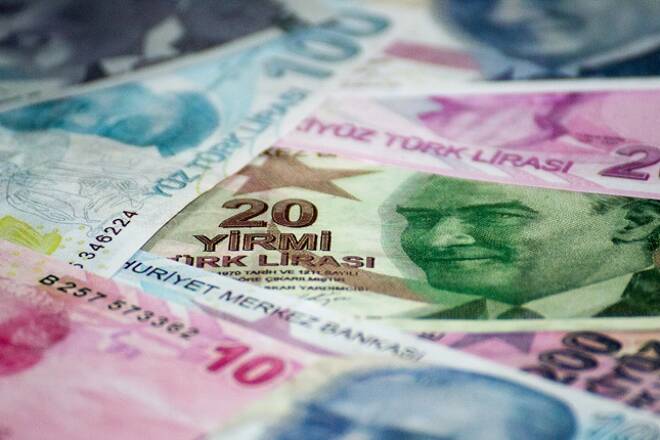Advertisement
Advertisement
Australian Dollar Jumps on Sharp Rise in Employment, No Surprises from the BoE and ECB, TRY Jumps as CBRT Increases Rates
By:
Australia’s employment rose a strong 44.0K in August, more than reversing the modest 4.3K drop in July. U.S. producer prices unexpectedly fell in August with the weakness led by declines in the prices of food and a range of trade services. U.S. crude oil production fell by 100,000 bpd, to 10.9 million bpd, as the industry faces pipeline capacity constraints. According to the Federal Reserve’s latest Beige Book released late Wednesday, three of the Fed’s 12 districts – St. Louis, Philadelphia and Kansas City – reported weaker growth in August. Fed Governor Lael Brainard said in a speech on Wednesday that the Federal Reserve likely will continue gradual interest rate increases but will accelerate the pace if signs that financial imbalances continue to build.
The Bank of England and the European Central Bank did not deliver any surprising news on Thursday, both banks kept interest rates unchanged. As expected, the BoE left its rate on 0.75%, the ECB kept its record low rates at 0.00%.
The Turkish Lira strengthens 2.87% versus the US dollar after the Central Bank of Turkey increased its interest rates from 17.75% to 24%.
Economic reports and the Fed were highlighted on Wednesday with volatility spread across the board from commodities to stocks to financials. The U.S. session featured reports on producer inflation and crude oil inventories as well as a speech from a Fed official and the central bank take on U.S. manufacturing. Early Thursday, investors are reacting to stronger-than-expected Australian employment data.
U.S. Economic Reports
According to the Labor Department, U.S. producer prices unexpectedly fell in August with the weakness led by declines in the prices of food and a range of trade services. The decline could have been worse if not for an increase in the cost of energy products.
The Producer Price Index (PPI) for final demand slipped 0.1 percent last month after being unchanged in July. August’s decline was the first in 1-1/2 years. Economists were looking for an increase of 0.2 percent in August.
In the 12 months through August, the PPI rose 2.8 percent, down from July’s 3.3 percent increase. Economists had forecast a 3.2 percent year-on-year reading.
Core PPI edged up 0.1 percent in August. In the 12 months through August, the core PPI increased 2.9 percent after rising 2.8 percent in July.
U.S. Energy Information Administration Inventories Report
Crude oil prices rose after an EIA report showed U.S. crude inventories fell 5.3 million barrels in the week to September 7 to 396.2 million barrels, the lowest since February 2015 and about 3 percent below the five-year average for this time of year.
Additionally, U.S. crude oil production fell by 100,000 bpd, to 10.9 million bpd, as the industry faces pipeline capacity constraints.
Gasoline stocks rose 1.3 million barrels, while distillate stockpiles, climbed by 6.2 million barrels, the EIA data showed.
Fed Beige Book
According to the Federal Reserve’s latest Beige Book released late Wednesday, three of the Fed’s 12 districts – St. Louis, Philadelphia and Kansas City – reported weaker growth in August. Additionally, the central bank said that while the overall U.S. economy expanded at a “moderate pace,” trade concerns and a lack of workers delayed projects. There were also “some signs of deliberation” in prices of final goods and services.
Fed Governor Lael Brainard
Fed Governor Lael Brainard said in a speech on Wednesday that the Federal Reserve likely will continue gradual interest rate increases but will accelerate the pace if signs that financial imbalances continue to build.
“While the information available to us today suggests that a gradual path is appropriate, we would not hesitate to act decisively if circumstances were to change,” Brainard said, according to prepared remarks. “If, for example, underlying inflation were to move abruptly and unexpectedly higher, it might be appropriate to depart from the gradual path.”
Australian Employment Report
Australia’s employment rose a strong 44.0K in August, more than reversing the modest 4.3K drop in July. Over the past three months, employment has risen an average of 33K per month. The strength was due to a sharp rise in full-time jobs (33.7K), while part-time jobs also rose (10.2K). The Unemployment Rate was stable at 5.3 percent, while the participation rate rose 65.7 percent.
About the Author
James Hyerczykauthor
James Hyerczyk is a U.S. based seasoned technical analyst and educator with over 40 years of experience in market analysis and trading, specializing in chart patterns and price movement. He is the author of two books on technical analysis and has a background in both futures and stock markets.
Advertisement
